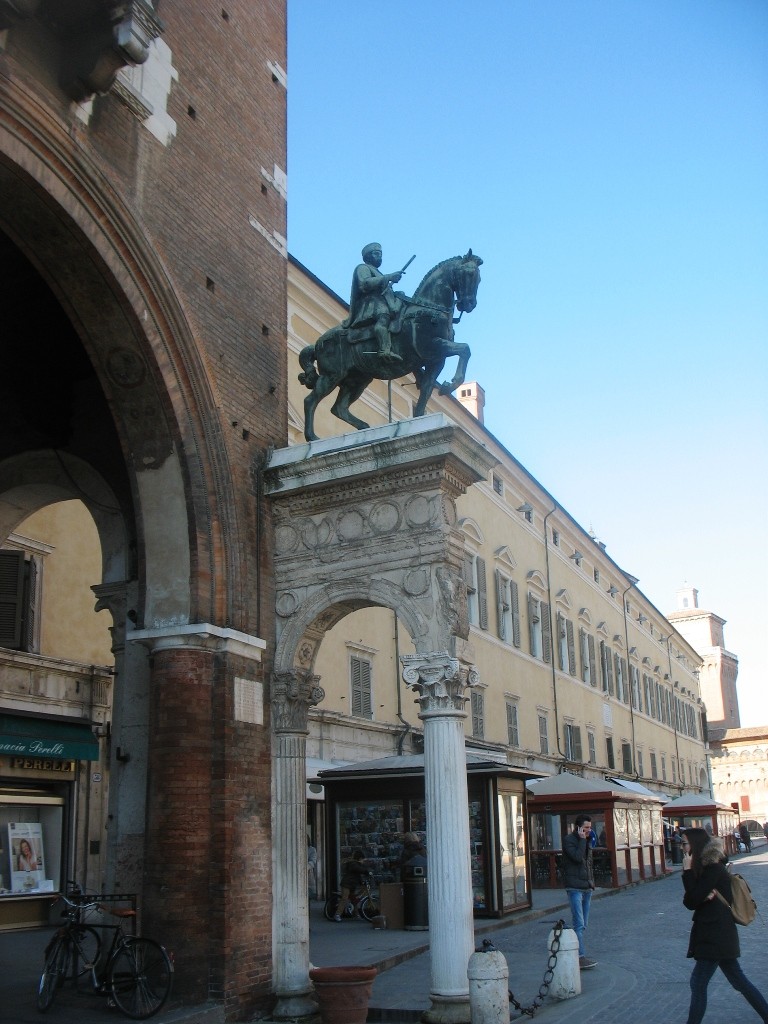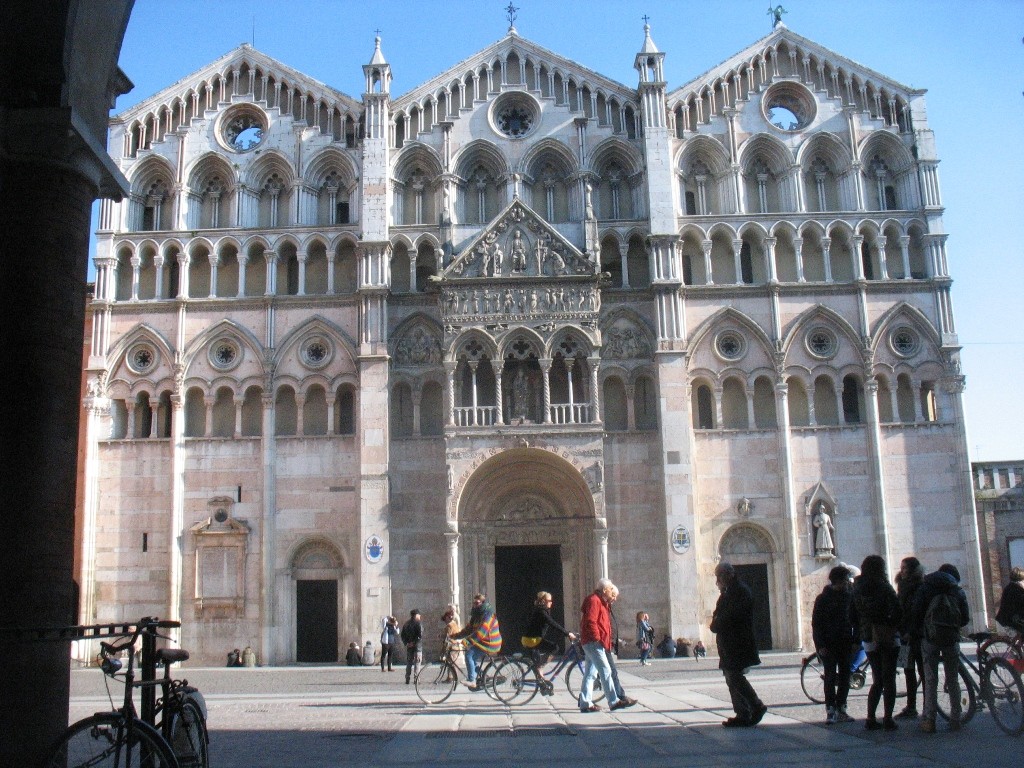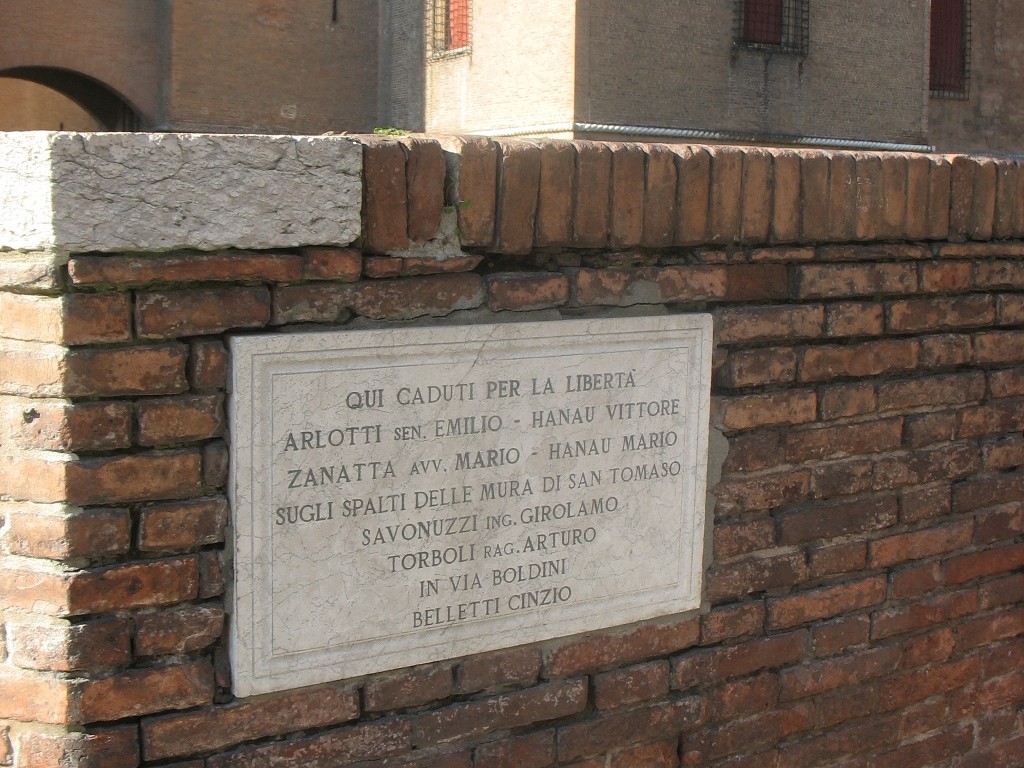Medieval gems in the centre
A pleasant walk along Via Mazzini will lead you to the heart of the city, announced by the tower bell of the Cathedral, looming behind the line of houses on the right side of the street. Entering Piazza Trento Trieste, you will be probably relieved to find a wide open space, after having wandered for a few kilometres in the maze of narrow streets of the medieval area. Formerly called Piazza delle Erbe, the square has housed for centuries the city market. Nowadays, instead, it is the setting for most of the many fascinating events taking place in Ferrara. Moreover, it is also the place where an interesting small market is organised in December.

Halfway through the square, it is possible to have a closer look to the bell tower and to the wall where a side entrance to the Cathedral (Porta dei Mesi) used to stand, before being destroyed in the 18th century. On the opposite side, instead, you will find the end of Via San Romano, which had been briefly dealt with in a previous entry. During the Middle Ages, it was the main way of access to the city centre. Despite having lost most of its original charm, it still presents some features of interest, namely the fine colonnade found on both sides and a good number of interesting shops.
Standing between Piazza Trento Trieste and the street bearing its own name, the church of San Romano deserves a few minutes of your time. The reason for it does not lie in its architectonic values, which is quite insignificant, but rather in the Museum of the Cathedral. This interesting collection, indeed, preserves a series of wonderful sculpted decorations, dating back to the 12th century and previously located on the above mentioned Porta dei Mesi. For this reason, they depict the activities traditionally carried out in the various parts of the year. Moreover, precious tapestries realised by the duke's craftsmen under the supervision of a Flemish master, are also found in the museum.

Back to Piazza Trento Trieste, you will head towards the end of the square, where the former ducal palace, currently housing the town hall, is located. Dating back to the 13th century, it was the residence of the Este family until the beginning of the 16th century. Following the body of the building, you will reach a wide arcade located right opposite the Cathedral. It is probably worth taking a few steps forward into the cozy Piazza Municipale. This will allow you not only to admire the square, which once corresponded to the courtyard of the ducal palace, but also to appreciate the fine staircase built in the 15th century.

Retracing your steps, the Cathedral will appear to you in all the splendour of its magnificent facade. Though chiefly bearing the marks of the Romanesque style, the church is the result of a mixture of various artistic periods. Indeed, its construction started at the beginning of the 12th century and was concluded only a few decades later, when the Gothic was already the predominant style. The most interesting feature of the Cathedral is probably the fascinating series of sculptures found on the facade, particularly the Judgement Day located above the central loggia. The tower, instead, was built only in the 16th century, probably by one of the most famous architects of the period, Leon Battista Alberti, following a project of the local architect Biagio Rossetti. Realised in white and pink marble, it is a characteristic example of the style of the Renaissance. Inside the church, you may admire the fine paintings of Benvenuto Tisi da Garofalo, Scarsellino and Guercino, besides the tomb of Pope Urbano III, buried in the Cathedral after his sudden death in Ferrara in 1187.

Leaving the Cathedral, it will not take too long to reach another symbol of the town: a few steps along Corso Martiri della Libertà, indeed, will take you in front of the Castello Estense. It is also interesting to notice, on your left, the peculiar statue representing Girolamo Savonarola, a peculiar protagonist of the 15th century, who was born in Ferrara in 1452. A small plaque, located on the parapet overlooking the moat, commemorates the massacre of a group of citizens who in 1943 were executed by the Fascists in that very point.

This dramatic episode has also been the basis for a film, called La lunga notte del '43, shot precisely in the centre of Ferrara. Back to Piazza Savonarola, it will be time to take a closer look to the castle. Once crossed the archway connecting the building to the ducal palace, you will find the entrance to the fortress, built at the end of the 14th century exactly with the purpose of providing the dukes with a safe shelter in the event of popular uprisings. In the following centuries, the castle began the seat of the Este court, acquiring then a less threatening aspect. It is possible to visit part of the fortress, in order to admire the fine square yard, the inner rooms decorated by wonderful frescoes, but also the ancient prison where the conspirators or the traitors were usually incarcerated.

Photo gallery
Content available in other languages
- Italiano: Le medievali gemme del centro
- Português: Gemas medievais no centro
- Español: Los monumentos medievales del centro
Want to have your own Erasmus blog?
If you are experiencing living abroad, you're an avid traveller or want to promote the city where you live... create your own blog and share your adventures!
I want to create my Erasmus blog! →





















Comments (0 comments)